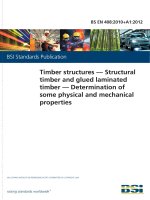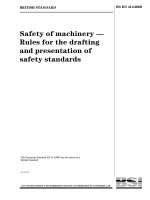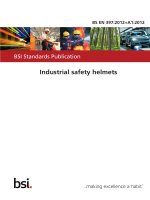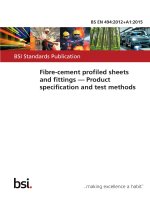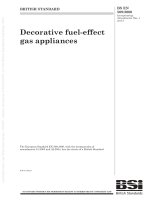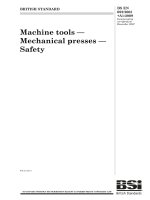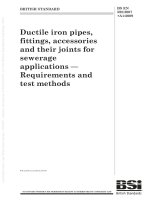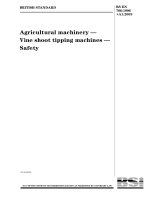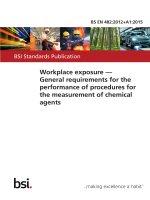Bsi bs en 01494 2000 + a1 2008 (2009)
Bạn đang xem bản rút gọn của tài liệu. Xem và tải ngay bản đầy đủ của tài liệu tại đây (596.54 KB, 48 trang )
BRITISH STANDARD
Mobile or movable jacks
and associated lifting
equipment
ICS 53.020.99
NO COPYING WITHOUT BSI PERMISSION EXCEPT AS PERMITTED BY COPYRIGHT LAW
| BS EN
|
|
| 1494:2000
|
|
| +A1:2008
|
| Incorporating
|
| corrigendum
|
| September 2001
|
|
|
|
|
|
|
|
|
|
|
|
|
|
|
|
|
|
|
|
|
|
|
|
|
|
|
|
|
|
|
|
|
|
|
|
|
|
|
|
|
|
|
|
|
|
|
|
|
|
|
|
|
|
|
|
|
|
|
|
|
|
|
|
|
|
|
|
|
|
|
|
|
|
|
|
|
|
|
|
|
|
|
|
|
|
|
|
|
|
|
|
|
|
|
|
|
|
|
|
|
|
|
|
|
|
|
|
|
|
|
|
|
|
|
|
BS EN 1494:2000+A1: 2008
National foreword
This British Standard is the UK implementation of EN 1494:2000+A1:2008.
It supersedes BS EN 1494:2000 which is withdrawn.
The start and finish of text introduced or altered by amendment is indicated in
the text by tags. Tags indicating changes to CEN text carry the number of the
CEN amendment. For example, text altered by CEN amendment A1 is indicated
by
.
The UK participation in its preparation was entrusted to Technical Committee
MHE/12, Lifting platforms.
ab
A list of organizations represented on this committee can be obtained on
request to its secretary.
This publication does not purport to include all the necessary provisions of a
contract. Users are responsible for its correct application.
Compliance with a British Standard cannot confer immunity from
legal obligations.
Amendments/corrigenda issued since publication
This British Standard
was published
under the authority of the
Standards Committee and comes
into effect on 15 February 2001
© BSI 2009
ISBN 978 0 580 61614 3
Amd. No.
Date
Comments
13250
Corrigendum No. 1
17 September 2001
Incorporating CEN
correction notice 25 April 2001.
Correction to Annex ZA
30 April 2009
Implementation of CEN
amendment A1:2008, and
alignment of BSI and CEN
publica\tion dates
EUROPEAN STANDARD
EN 1494:2000+A1
NORME EUROPÉENNE
EUROPÄISCHE NORM
December 2008
ICS 53.020.99
Supersedes EN 1494:2000
English Version
Mobile or movable jacks and associated lifting equipment
Crics mobiles ou dộplaỗables et équipements de levage
associés
Fahrbare oder ortsveränderliche Hubgeräte und verwandte
Einrichtungen
This European Standard was approved by CEN on 18 October 2000 and includes Amendment 1 approved by CEN on 9 November 2008.
CEN members are bound to comply with the CEN/CENELEC Internal Regulations which stipulate the conditions for giving this European
Standard the status of a national standard without any alteration. Up-to-date lists and bibliographical references concerning such national
standards may be obtained on application to the CEN Management Centre or to any CEN member.
This European Standard exists in three official versions (English, French, German). A version in any other language made by translation
under the responsibility of a CEN member into its own language and notified to the CEN Management Centre has the same status as the
official versions.
CEN members are the national standards bodies of Austria, Belgium, Bulgaria, Cyprus, Czech Republic, Denmark, Estonia, Finland,
France, Germany, Greece, Hungary, Iceland, Ireland, Italy, Latvia, Lithuania, Luxembourg, Malta, Netherlands, Norway, Poland, Portugal,
Romania, Slovakia, Slovenia, Spain, Sweden, Switzerland and United Kingdom.
EUROPEAN COMMITTEE FOR STANDARDIZATION
COMITÉ EUROPÉEN DE NORMALISATION
EUROPÄISCHES KOMITEE FÜR NORMUNG
Management Centre: rue de Stassart, 36
© 2008 CEN
All rights of exploitation in any form and by any means reserved
worldwide for CEN national Members.
B-1050 Brussels
Ref. No. EN 1494:2000+A1:2008: E
BS EN 1494:2000+A1:2008
EN 1494:2000+A1:2008 (E)
Contents
Page
Foreword..............................................................................................................................................................4
Introduction .........................................................................................................................................................5
1
Scope ......................................................................................................................................................5
2
Normative references ............................................................................................................................7
3
Terms and definitions ...........................................................................................................................7
4
List of hazards......................................................................................................................................12
5
5.1
5.1.1
5.1.2
5.1.3
5.1.4
5.1.5
5.2
5.3
5.4
5.5
5.5.1
5.5.2
5.5.3
5.5.4
5.6
5.6.1
5.6.2
5.6.3
5.6.4
5.6.5
5.6.6
5.6.7
5.7
5.8
5.8.1
5.8.2
5.8.3
5.8.4
5.9
5.10
5.11
5.12
5.13
5.14
5.15
5.16
5.17
5.17.1
5.17.2
5.18
5.18.1
5.18.2
Safety requirements ............................................................................................................................17
Braking device .....................................................................................................................................17
General..................................................................................................................................................17
Dimensioning .......................................................................................................................................17
Interruption of the power flow ............................................................................................................17
Automatic operation ............................................................................................................................17
Alterations ............................................................................................................................................17
Security against dropping ..................................................................................................................17
Speeds ..................................................................................................................................................17
Security against overloading..............................................................................................................18
Transmission systems ........................................................................................................................18
Security of guides................................................................................................................................18
End stops..............................................................................................................................................18
Additional requirements for hydraulic jacks ....................................................................................19
Additional requirements for pneumatic jacks ..................................................................................19
Control devices ....................................................................................................................................20
Hold to run control...............................................................................................................................20
Unintentional operation ......................................................................................................................20
Identification.........................................................................................................................................20
Obviousness ........................................................................................................................................20
Visibility ................................................................................................................................................23
Control devices of manually operated jacks ....................................................................................23
External power supply ........................................................................................................................24
Combined manual and power-operated jacks ..................................................................................24
Requirements for safety mechanisms...............................................................................................24
Adjustments .........................................................................................................................................24
Materials ...............................................................................................................................................24
Effects of weather and dirt..................................................................................................................25
Breakage of springs ............................................................................................................................25
Lift pad ..................................................................................................................................................25
Structural design .................................................................................................................................25
Climatic conditions..............................................................................................................................25
Hot surfaces .........................................................................................................................................25
Forces ...................................................................................................................................................26
Protection against pinching and shearing........................................................................................26
Electricity..............................................................................................................................................26
Transport and installation equipment ...............................................................................................26
Provisions for maintenance................................................................................................................26
Accessibility .........................................................................................................................................26
Adjustment ...........................................................................................................................................26
Special requirements for hydraulic transmission jacks ..................................................................26
Holding device .....................................................................................................................................26
Lowering speed....................................................................................................................................27
2
BS EN 1494:2000+A1:2008
EN 1494:2000+A1:2008 (E)
5.19
5.19.1
5.19.2
5.20
5.20.1
5.20.2
5.20.3
5.20.4
5.20.5
5.20.6
5.21
Special requirements for trolley jacks ..............................................................................................27
Guidance of the lift pad.......................................................................................................................27
Lowering of the load ...........................................................................................................................27
Special requirements for pit jacks.....................................................................................................27
Overturning protection .......................................................................................................................27
Lowering speed ...................................................................................................................................27
Adjustments .........................................................................................................................................27
Hold to run control ..............................................................................................................................27
Unintentional operation ......................................................................................................................27
Crash protection ..................................................................................................................................27
Special requirements for jacks without integrated pump ...............................................................27
6
6.1
6.1.1
6.1.2
6.1.3
6.1.4
6.1.5
6.1.6
6.2
Verification ...........................................................................................................................................28
General .................................................................................................................................................28
Tests .....................................................................................................................................................28
Design check .......................................................................................................................................28
Manufacturing check...........................................................................................................................28
Visual verification................................................................................................................................29
Practical tests ......................................................................................................................................29
Electrical tests .....................................................................................................................................29
Individual final verification before despatch ....................................................................................29
7
7.1
7.1.1
7.1.2
7.1.3
7.2
Information for use..............................................................................................................................29
Instruction for use and instruction handbook..................................................................................29
General .................................................................................................................................................30
Rules for operating..............................................................................................................................30
Maintenance and repair ......................................................................................................................31
Minimum marking................................................................................................................................31
Annex A (normative) Noise ..............................................................................................................................32
Annex B (normative) Test procedures............................................................................................................33
Annex C (normative) Manual forces and manual force measurement methods........................................41
Annex ZA (informative) !Relationship between this European Standard and the Essential
Requirements of EU Directive 98/37/EC" ......................................................................................43
Annex ZB (informative) !Relationship between this European Standard and the Essential
Requirements of EU Directive 2006/42/EC" ..................................................................................44
3
BS EN 1494:2000+A1:2008
EN 1494:2000+A1:2008 (E)
Foreword
This (EN 1494:2000+A1:2008) has been prepared by Technical Committee CEN/TC 98 "Lifting platforms", the
secretariat of which is held by DIN.
This European Standard shall be given the status of a national standard, either by publication of an identical
text or by endorsement, at the latest by June 2009, and conflicting national standards shall be withdrawn at
the latest by December 2009.
This document includes Amendment 1, approved by CEN on 2008-11-09.
This document supersedes EN 1494:2000.
The start and finish of text introduced or altered by amendment is indicated in the text by tags ! ".
This European Standard has been prepared under a mandate given to CEN by the European Commission
and the European Free Trade Association, and supports essential requirements of EU Directive(s).
!For relationship with EU Directive(s), see informative Annexes ZA and ZB, which are integral parts of this
standard."
!deleted text"
According to the CEN/CENELEC Internal Regulations, the national standards organizations of the following
countries are bound to implement this European Standard: Austria, Belgium, Bulgaria, Cyprus, Czech
Republic, Denmark, Estonia, Finland, France, Germany, Greece, Hungary, Iceland, Ireland, Italy, Latvia,
Lithuania, Luxembourg, Malta, Netherlands, Norway, Poland, Portugal, Romania, Slovakia, Slovenia, Spain,
Sweden, Switzerland and United Kingdom.
4
BS EN 1494:2000+A1:2008
EN 1494:2000+A1:2008 (E)
Introduction
!This European Standard is a type C standard as stated in EN ISO 12100-1:2003."
This standard has been prepared to be a harmonised standard to provide one means of conforming with the
essential Safety Requirements of the Machinery Directive and associated EFTA Regulations.
The object of this European Standard is to define rules for safeguarding persons against the risk of accidents
associated with the operation of mobile or movable jacks.
The extent to which hazards are covered is indicated in the scope of this standard. In addition, machinery
should comply as appropriate with !EN ISO 12100" for hazards which are not covered by this standard.
While producing this standard it was assumed that
only trained persons operate the lifting equipment;
the working area is adequately light;
harmful materials such as asbestos are not used;
components are kept in good repair and working order;
by design of the load bearing elements a safe operation of the machine is assured for loads up to 100 %
of the rated load and during the tests under the conditions given by the manufacturer;
a negotiation for special uses took place between the user and the manufacturer;
components without specific requirements are
a) designed in accordance with the usual engineering practice and calculation methods, including all
failure modes;
b) of sound mechanical and electrical construction;
c) made of materials with adequate strength and of suitable quality.
1
Scope
This European Standard specifies technical safety requirements and measures for mobile or movable jacks
(see 3.6) and associated lifting equipment.
This European Standard deals with all significant hazards pertinent to mobile or movable jacks and associated
lifting equipment when they are used as intended and under the conditions foreseen by the manufacturer. This
European Standard specifies the appropriate technical measures to eliminate or reduce risks arising from the
significant hazards.
This standard applies to lifting equipment (see 3.1) which are mobile or movable and designed to operate
under the load, whether operated singulary or in multiples to partially or totally raise and lower loads or
vehicles at one or more lifting points (excluding the lifting of persons) where working under the raised load is
not permitted unless additional means of securing the load in position are in place.
5
BS EN 1494:2000+A1:2008
EN 1494:2000+A1:2008 (E)
NOTE
Associated lifting equipment means lifting equipment which is similar to those defined in 3.1, but which does
not fully comply with these definitions.
This standard does not establish additional requirements for
power drive by an internal combustion machine;
stability of the mobile or movable jacks and associated lifting equipment;
operation in severe conditions (e.g. extreme climates, freezer application, strong magnetic fields);
operation subject to special rules (e.g. potentially explosive atmospheres, mines);
supply by electrical networks where the tolerances in voltage, frequency etc. differ from those in the
public supplies;
static electric problems;
handling of loads, the nature of which could lead to dangerous situations (e.g. molten metal, acids,
radiating materials, especially brittle loads);
hazards occurring during producing and decommissioning;
hazards occurring when using the lifting equipment on public roads;
wind pressure in and out of use;
direct contact with foodstuffs;
operation on sea ships.
This standard applies e.g. to the following lifting equipment
mechanical jacks with or without claw;
hydraulic jacks with or without claw and with or without integrated pump, e. g. hydraulic trolley jacks,
hydraulic transmission jacks, hydraulic pit jacks;
pneumatic jacks.
This standard does not apply to
a)
jacks or stabilizers which are permanently fixed to a trailer or a container to support a trailer or container
without the tractor-unit;
b)
hydraulic cylinders which are permanently fixed to the vehicle for tipping and/or tilting parts of it;
c)
support stands with the possibility for changing the lift height only without the load;
d)
hydraulic lifting equipment working with a maximum pressure exceeding 500 bar and where pump and
cylinder are not integrated parts of the same equipment;
e)
jacks that are delivered with road vehicles for helping when a break-down occurs (including delivery of
original spare parts).
6
BS EN 1494:2000+A1:2008
EN 1494:2000+A1:2008 (E)
2
Normative references
This European Standard incorporates, by dated or undated reference, provisions from other publications.
These normative references are cited at the appropriate places in the text and the publications are listed
hereafter. For dated references, subsequent amendments to or revisions of any of these publications apply to
this European Standard only when incorporated in it by amendment or revision. For undated references the
latest edition of the publication applies (including amendments).
!deleted text"
EN 349, Safety of machinery — Minimum gaps to avoid crushing of parts of the human body
EN 811, Safety of machinery — Safety distances to prevent danger zones being reached by the lower limbs
EN 954-1:1996, Safety of machinery — Safety-related parts of control systems — Part 1: General principles
for design
!deleted text"
EN 60204-32, Safety of machinery — Electrical equipment of machines — Part 32: Requirements for hoisting
machines (IEC 60204-32:1998)
EN 60947-5-1:1997, Low-voltage switchgear and controlgear — Part 5-1: Control circuit devices and switching
elements — Electromechanical control circuit devices (IEC 60947-5-1:1997)
EN 61496-1:1997, Safety of machinery — Electro-sensitive protective devices — Part 1: General
requirements and tests (IEC 61496-1:1997)
EN ISO 4871, Acoustics— Declaration and verification of noise emission values of machinery and equipment
(ISO 4871:1996)
EN ISO 11201:1995, Acoustics— Noise emitted by machinery and equipment — Measurement of emission
sound pressure levels at a work station and at other specified positions — Engineering method in an
essentially free field over a reflecting plane (ISO 11201:1995)
!EN ISO 12100-1:2003, Safety of machinery — Basic concepts, general principles for design — Part 1:
Basic terminology, methodology (ISO 12100-1:2003)
EN ISO 12100-2:2003, Safety of machinery — Basic concepts, general principles for design — Part 2:
Technical principles (ISO 12100-2:2003)"
3
Terms and definitions
For the purposes of this standard, the following terms and definitions apply:
3.1
lifting equipment
device which permits a load to be raised, lowered or moved.
Lifting equipments within the meaning of this standard are:
3.1.1
mechanical jack
Jack in which the load is moved by means of mechanical devices, e. g. rack and pinion jack, screw type bottle
jack or mechanical elevator such as a mechanical transmission jack. The jack can also be equipped with
claws.
7
BS EN 1494:2000+A1:2008
EN 1494:2000+A1:2008 (E)
Figure 1 — Examples of mechanical jacks
3.1.2
hydraulic jack
jack in which the load is moved by means of hydraulic
NOTE
All types of hydraulic jacks can exist in principle also as pneumatic jack.
3.1.2.1
hydraulic jack with integrated pump
hydraulic jack where the pump is integrated in the jack
Figure 2 — Example of hydraulic jack with integrated pump
3.1.2.2
hydraulic jack without integrated pump
hydraulic jack where the pump is not integrated in the jack
8
BS EN 1494:2000+A1:2008
EN 1494:2000+A1:2008 (E)
Figure 3 — Example of hydraulic jack without integrated pump
3.1.2.3
hydraulic claw jack
Hydraulic jack equipped with a claw. This does not exclude an additional lift pad.
3.1.2.4
hydraulic trolley jack
manually movable trolley device of which the carried load is set in vertical movement by a hydraulic system
Key
1 lift pad
2 lifting beam
Figure 4 — Example of hydraulic trolley jack
9
BS EN 1494:2000+A1:2008
EN 1494:2000+A1:2008 (E)
3.1.2.5
hydraulic transmission jack
hydraulic jack mobile freely on the ground, designed to lift loads or to partially lift vehicles
Figure 5 — Examples of hydraulic transmission jacks
3.1.2.6
hydraulic pit jack
rail guided hydraulic jack on cradle designed to lift loads or to partially lift vehicles
10
BS EN 1494:2000+A1:2008
EN 1494:2000+A1:2008 (E)
Figure 6 — Example of hydraulic pit jack
3.1.3
pneumatic jack
jack of which the carried load is set in vertical movement by a pneumatic system (see note in 3.1.2)
3.2 Power sources for lifting equipment
3.2.1
manual
the drive results on muscular force
3.2.2
pneumatic
the drive results on gaseous substances under pressure
3.2.3
hydraulic
the drive results on hydraulic fluid under pressure
3.2.4
electric
the drive results on electrical energy
3.3
power driven jack
jack in which the drive does not result on muscular force
3.4
stroke
maximum powered vertical distance that the lifting point can cover
3.5
Loads
3.5.1
rated load
maximum load that a lifting equipment has been designed to carry throughout the whole stroke when operated
as intended by the manufacturer and which is marked on the load plate
11
BS EN 1494:2000+A1:2008
EN 1494:2000+A1:2008 (E)
3.5.2
maximum possible load
maximum load that a lifting equipment complying with the requirements of this standard is able to carry due to
the setting of the load limiting device
3.6 Change of place
3.6.1
movable
jack designed not to move or to be moved whilst under load (well when unloaded)
3.6.2
mobile
jack designed to move or be moved whilst under load
3.6.3
restraint guided
mobile or movable jack which only can be moved within a guiding
3.7
hold to run control
control device which initiates and maintains operation of machine elements only as long as the manual control
(actuator) is actuated and the manual control (actuator) automatically returns to the stop position when
released !(see 3.26.3 of EN ISO 12100-1:2003)"
3.8 Braking of the load supporting device
3.8.1
automatic brake
Braking device which is normally held on and which is released only by application of power. Operation is also
instigated automatically by releasing the controls of the jack and by interruption of the power supply.
3.8.2
self braking drive
drive to stop automatically the movement of the load supporting device, as well unloaded as loaded with rated
load, also after running-in, e. g. by a self braking spindle
3.8.3
load pressure brake
the braking force depends on the load and increases proportionally to the load
3.9
lift pad
load carrying part of the jack
3.10
claw
side fitted load bearing point
4
List of hazards
The following hazards from Annex A of EN 414 are applicable in the Situation described and could involve
risks to persons if not reduced or eliminated. The corresponding requirements are designed to limit the risk or
reduce these hazards in each situation.
12
BS EN 1494:2000+A1:2008
EN 1494:2000+A1:2008 (E)
Table 1 — List of hazards
HAZARDS
CORRESPONDING REQUIREMENT
1
Mechanical hazards
1.1
Crushing hazards
5.6.1, 5.6.2, 5.14
1.2
Shearing hazard
5.6.1, 5.6.2, 5.14
1.3
Cutting or severing hazard
5.6.1, 5.6.2, 5.14
1.4
Entanglement hazard
not applicable
1.5
Drawing-in or trapping hazard
not applicable
1.6
Impact hazard
5.6.6, 5.7
1.7
Stabbing or puncture hazard
not applicable
1.8
Friction or abrasion hazard
not applicable
1.9
High pressure fluid injection hazard
5.5.3.7, 5.5.3.8
1.10
Ejection of parts (of machinery and
processed materials/workpieces)
not applicable
1.11
Loss of stability (of machinery and
machine parts)
5.9, 5.10, 5.11, 5.20.1, 5.20.6
1.12
Slip, trip and fall hazards in relationship
with machinery (because of their
mechanical nature).
not applicable
2
Electrical hazards
2.1
Electrical contact direct or indirect
5.15
2.2
Electrostatic phenomena
not applicable
2.3
Thermal radiation or other phenomena
such as ejection of molten particles, and
chemical effects from short-circuits,
overloads etc.
5.15
2.4
External influences on electrical
equipment
5.15
3
Thermal hazards resulting in:
3.1
Burns and scalds, by a possible contact
of persons, by flames or explosions and
also by the radiation of heat sources
5.12
Health-damaging effects by hot or cold
work environment
not applicable
3.2
4
Hazards generated by noise
4.1
Hearing losses (deafness), other
physiological disorders (e.g. loss of
balance, loss of awareness, etc.)
4.2
5
interferences with speech
communication, acoustic signals, etc.
Annex A
Annex A
Hazards generated by vibration (resulting not applicable
in a variety of neurological and vascular
disorders)
13
BS EN 1494:2000+A1:2008
EN 1494:2000+A1:2008 (E)
Table 1 — List of hazards
HAZARDS
CORRESPONDING REQUIREMENT
6
Hazards generated by radiation,
especially by:
6.1
electrical arcs
not applicable
6.2
lasers
not applicable
6.3
ionizing radiation sources
not applicable
6.4
machines making use of high frequency
electro magnetic fields
not applicable
7
Hazards generated by materials and
substances processed, used or
exhausted by machinery
0, 5.10
7.1
Hazards resulting from contact with or
inhalation of harmful fluids, gases, mists,
fumes and dust
not applicable
7.2
Fire or explosion hazard
not applicable
7.3
biological and microbiological (viral or
bacterial) hazards
not applicable
8
Hazards generated by neglecting
ergonomic principles in machine design
(mismatch of machinery with human
characteristics and abilities) caused for
example by
8.1
unhealthy postures or excessive efforts
8.2
inadequate consideration of human hand- not applicable
arm or foot-leg anatomy
8.3
neglected use of personal protection
equipment
not applicable
8.4
inadequate area lighting
0
8.5
mental overload or underload, stress, etc. not applicable
8.6
human error
5.6.1, 5.6.2, 5.6.3, 5.6.4, 5.6.5, 5.6.6
9
10
Hazards combinations
not applicable
10.1
failure of energy supply (of energy and/or
control circuits)
5.8.4
10.2
unexpected ejection of machine parts or
fluids
5.5.3.1, 5.5.3.7, 5.5.3.8
10.3
failure/disorder of control system
(unexpected start up, unexpected
overrun)
5.6.1, 5.8.1, 5.8.3
10.4
errors of fitting
7.1.3
10.5
overturn, unexpected loss of machine
stability
7.1.2
14
5.13, 5.16
Hazards caused by failure of energy
supply, breaking down of machinery parts
and other functional disorders
BS EN 1494:2000+A1:2008
EN 1494:2000+A1:2008 (E)
Table 1 — List of hazards
HAZARDS
CORRESPONDING REQUIREMENT
11
Hazards caused by (temporary) missing
and/or incorrect positioned safety related
measures/means
11.1
all kinds of guard
not applicable
11.2
all kinds of safety related (protection)
devices
7.1.2, 7.1.3
11.3
starting and stopping devices
7.1.2, 7.1.3
11.4
safety signs and tags
5.6.3
11.5
all kinds of information or warning devices 7.1, 7.2
11.6
energy supply disconnecting devices
5.15
11.7
emergency devices
5.1.4, 5.6.7
11.8
feeding/removal means of workpieces
not applicable
11.9
essential equipment and accessories for
safe adjusting and/or maintaining
5.8.1, 5.17.2
1.10
equipment evacuating, gases, etc.
not applicable
HAZARDS DUE TO MOBILITY
12
Inadequate lighting of moving/working
area
0
13
Hazards due to sudden movement,
instability etc. during handling
5.20.6
14
Inadequate/inergonomic design of
driving/operating position
14.1
hazards due to dangerous environments
(contact with moving parts, exhaust
gases etc.)
not applicable
14.2
inadequate visibility from
driver's/operator's position
5.6.5
14.3
inadequate seat/seating (seat index
point)
not applicable
14.4
inadequate/inergonomic
design/positioning of controls
5.13
14.5
- starting/moving of self-propelled
machinery
not applicable
14.6
- road traffic of self-propelled machinery
not applicable
14.7
- movement of pedestrian controlled
machinery
not applicable
15
BS EN 1494:2000+A1:2008
EN 1494:2000+A1:2008 (E)
Table 1 — List of hazards
HAZARDS
CORRESPONDING REQUIREMENT
15
Mechanical hazards
15.1
hazards to exposed persons due to
uncontrolled movement
not applicable
15.2
hazards due to break-up and/or ejection
of parts
5.8.2, 5.8.4
15.3
hazards due to rolling over (deflection
limiting volume; DVL)
not applicable
15.4
hazards due to falling objects
5.18.1
15.5
inadequate means of access
not applicable
15.6
hazards caused due to towing, coupling,
connecting, transmission etc.
5.13
15.7
hazards due to batteries, fire, emissions
etc.
not applicable
HAZARDS DUE TO LIFTING
OPERATION
16.1
lack of stability
5.9
16.2
derailment of machinery
5.5.1, 5.5.2
16.3
loss of mechanical strength of machinery
and lifting accessories
5.5.3.1, 5.5.4.1, 5.10
16.4
hazards caused by uncontrolled
movement
5.1, 5.2
16.5
hazards due to falling loads
5.18.1
17
inadequate view of trajectories of the
moving parts
5.6.5
18
hazards caused by lighting
not applicable
19
hazards due to loading/ overloading
5.4
16
BS EN 1494:2000+A1:2008
EN 1494:2000+A1:2008 (E)
5
Safety requirements
5.1 Braking device
5.1.1
General
Jacks shall be designed or equipped in a way that the load can be restrained and held. Unintentional descent
shall be prevented.
This requirement may be fulfilled e.g. by
a)
self-blocking drives for manual driven jacks and self-braking drives-for power driven jacks;
b)
automatic brakes;
c)
a load pressure brake in conjunction with a blocking device, e. g. automatically engaging pawls;
d)
non-return valves at the supporting cylinder.
"Automatically engaging“ means that a pawl is forced to drop into place by reason of its design or through the
force of a spring. For the use of springs see 5.8.4.
NOTE
Descent of the load when the supply of energy is interrupted or irregular is regarded as unintentional descent.
Lowering the load e.g. by opening the brake with the control device is regarded as intentional descent.
5.1.2
Dimensioning
Braking mechanisms shall be constructed in a way that the forces generated during braking can be safely
restrained by the jack in any position of the load carrying device.
5.1.3
Interruption of the power flow
There shall be no device between the load carrying device and the braking device which the can interrupt the
power flow.
5.1.4
Automatic operation
Braking mechanisms shall operate automatically after the control device has returned to the „Off“ position or
when the drive power is interrupted or when the mechanisms described in 5.4 and 5.5.2.2 have responded.
NOTE
5.1.5
Return to the "Off“ position means for manual driven jacks when no operating force is applied.
Alterations
Braking mechanisms shall be designed in a way that the operator cannot alter their constructionally defined
effect without the aid of tools.
5.2 Security against dropping
On manual driven hydraulic and pneumatic jacks it shall be possible for the operator to regulate the lowering
speed or stop the lowering at any load up to the rated load.
5.3 Speeds
The maximum admissible average speed of descend for a jack, loaded with the rated load, is 0,15 m/s.
17
BS EN 1494:2000+A1:2008
EN 1494:2000+A1:2008 (E)
5.4 Security against overloading
Hydraulic and pneumatic jacks with a rated load of more than 100 kg and power driven mechanical jacks with
a rated load of 1 000 kg at least shall be fitted with security devices against overloading.
This requirement can be fulfilled e. g. by
a)
torque limiters;
b)
pressure relief valves;
c)
limitation of driving energy.
These devices shall be set to the lowest possible value between 100 % and 125 % of the rated load. These
devices shall be protected against unauthorized adjustment.
5.5 Transmission systems
5.5.1
Security of guides
Jacks shall be so equipped that rackstrips, spindles or pistons cannot unintentionally loosen from their guides.
This requirement shall be fulfilled in the case of cylinders if the piston is mechanically prevented from coming
out of the cylinder.
5.5.2
5.5.2.1
End stops
Limitation of end positions
Each end position of jacks shall be limited mechanically or hydraulically. The forces generated when reaching
the end positions shall be absorbed safely by the jacks. It shall not be possible to put these end-stop
mechanisms unintentionally out of action.
5.5.2.2
End-stop mechanism
If power-driven jacks are provided with an automatic end-stop mechanism to limit the upwards and
downwards travel the movement in the opposite direction shall still be possible when the automatic
mechanism has responded.
Such end-stop mechanisms may be e. g.
a)
end-stop switches fulfilling the requirements of chapter 3 of EN 60947-5-1:1997 which are fitted in such a
way that overshoot is taken into account, or
b)
slip-clutches which are fitted to limit the working travel safely, or
c)
pressure relief valves which are fitted in hydraulic or pneumatic systems to limit the working travel.
5.5.2.3
Height adaption spindle
Load carrying devices fitted with a height adaption spindle shall be provided with an automatic operating
spindle travel stop which prevents turning out.
18
